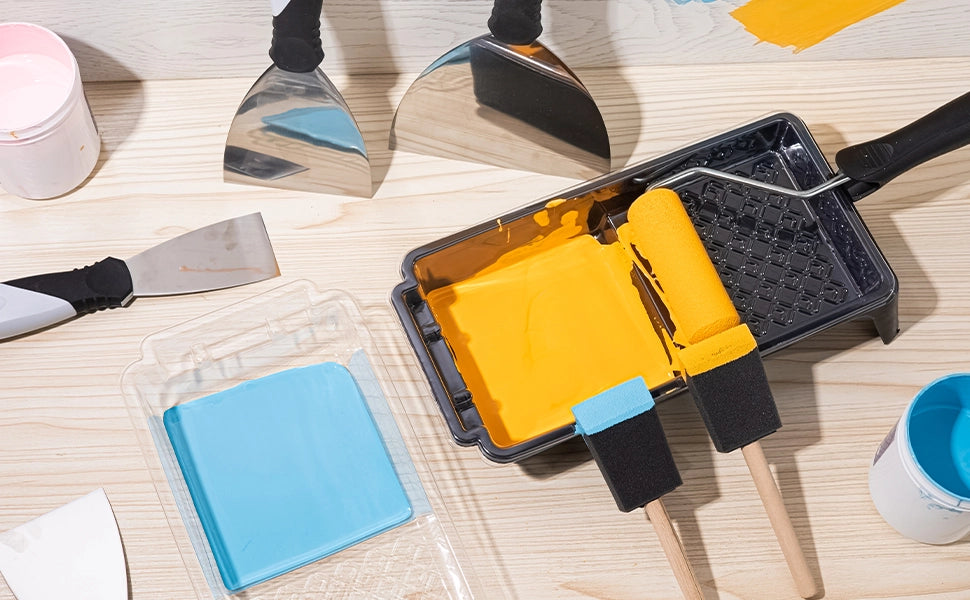As a professional painter, I know how crucial it is to keep paint tools like paint rollers, paint brushes, and related equipment clean and well-maintained. Proper cleaning and maintenance not only extend the lifespan of these tools but also ensure the best performance every time you use them. In this blog, I'll share practical tips to help you efficiently clean and care for your painting tools.
Why Is Cleaning and Maintaining Paint Tools Important?
- Save Money: High-quality paint tools can be expensive. Regular maintenance prevents frequent replacements.
- Improve Painting Results: Clean tools ensure smooth, even application and prevent streaks or debris in your work.
- Save Time: Maintaining tools reduces delays caused by damaged or poorly-performing equipment.
Step-by-Step Guide to Cleaning Paint Tools
1. Cleaning Paint Rollers
Paint rollers are essential for covering large surfaces, but they can be tricky to clean if paint dries on them.
Steps:
- Remove Excess Paint: Use a paint scraper (like the Mister Rui 10-in-1 Putty Knife) to gently scrape off as much excess paint as possible from the roller.
-
Rinse and Wash:
- For Latex Paint: Soak the roller in warm water with a small amount of mild detergent. Use your hands to gently squeeze and work out the paint until the water runs clear.
- For Oil-Based Paint: Submerge the roller in a solvent like mineral spirits or turpentine. Once the paint is dissolved, rinse it thoroughly with clean water.
- Dry: Pat the roller with a clean towel to remove excess water and hang it to air dry, ensuring it keeps its shape.
Pro Tip: If you need to reuse the roller within a short time, wrap it tightly in plastic wrap or place it in a sealed plastic bag and store it in the refrigerator. This prevents the paint from drying out.
2. Cleaning Paint Brushes
Paint brushes have densely packed bristles that require extra care to keep them clean and functional.
Steps:
- Remove Excess Paint: Wipe off as much paint as possible on scrap paper or cardboard. Use the putty knife to scrape the base of the bristles gently if needed.
-
Rinse and Wash:
- For Latex Paint: Rinse the brush under warm running water while gently working the bristles with your hand. Use your fingers to comb through the bristles, ensuring all paint is removed.
- For Oil-Based Paint: Soak the brush in a solvent like turpentine or mineral spirits, then wash with soapy water. Rinse thoroughly with clean water.
- Reshape the Bristles: After cleaning, use your fingers to reshape the bristles into their original form.
- Dry: Hang the brush with the bristles pointing down or lay it flat to dry. Avoid letting the bristles rest on a surface, which could cause them to bend.
Pro Tip: For long-term storage, apply a small amount of bristle conditioner or petroleum jelly to protect the bristles and keep them soft.
3. Cleaning Other Tools
- Paint Trays: Scrape off excess paint with the putty knife. For dried paint, use a solvent to soften it before cleaning with warm soapy water.
- Scrapers and Putty Knives: Wipe off wet paint with a paper towel or cloth. For dried paint, use a razor blade (such as the one included in the Mister Rui Putty Knife) to scrape it off. Wash with water or a solvent if necessary, then dry thoroughly.
- Other Small Tools: Clean with water and soap or an appropriate solvent, then dry and store them properly.
Tips for Maintaining Paint Tools
1. Regular Inspections
Check your tools after each use for signs of wear, such as loose brush bristles, damaged roller covers, or rusted metal parts. Repair or replace tools as needed.
2. Proper Storage
- Store tools in a dry, cool place away from direct sunlight or moisture to prevent warping or rust.
- Use a dedicated tool organizer or hang tools to keep them clean and in good shape.
3. Deep Cleaning
Beyond daily cleaning, consider doing a deep clean of your tools every few months, especially if they’ve been used heavily. This removes any hidden paint buildup or debris.
How to Handle Stubborn Paint Residue
If your tools have dried paint or stubborn residue, try these methods:
- Use a commercial paint remover or cleaning solution.
- For brushes, comb through the bristles with an old toothbrush or a fine-toothed comb.
- Use the putty knife or a scraper to gently remove dried paint from rollers, trays, or other surfaces.
- Soak tools in a solvent for a longer time if necessary, but avoid soaking brushes too long as it may damage the bristles.
Conclusion
Efficiently cleaning and maintaining paint tools is an essential skill for any painter—professional or DIY enthusiast. By following these steps, you can keep your tools in excellent condition, ensure consistent results, and save money in the long run.
I hope these tips help you keep your paint tools in top shape! If you have any questions or additional tips to share, feel free to leave them in the comments below!



0 comments